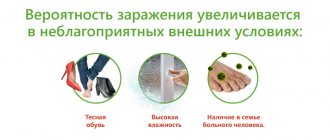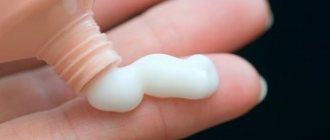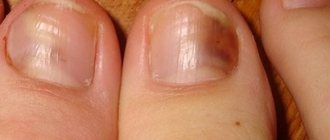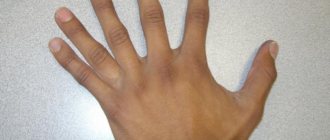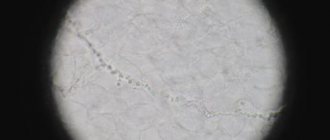Just a few years ago, fungal nail diseases were not given much importance, whereas now everyone understands the need for timely detection and treatment of a massive contagious fungal infection caused by a variety of dermatophyte fungi. Thanks to widespread public awareness, the number of visits to specialists with this pathology has increased, which in turn has led to an increase in the detection of mycoses of the feet. Since any deformation of the nail plate for no apparent reason (for example, injury) is primarily suspected of a fungal infection, self-diagnosis in this case is a decisive factor. Thus, any change in the nail plate is a reason to contact a dermatologist, because at least half of such disorders will have a fungal etiology, and the rest will require careful diagnosis, again carried out by a specialist.
Why, given the obvious simplicity of clinical diagnosis of fungal nail infections, do patients usually come to the appointment already with advanced forms of the disease? Most often, 4-5 toes are affected, with the most affected nail plate (usually the first toe) changed by more than half, and its thickening is about 2 mm. Such symptoms require long-term combined treatment, which is reflected in its cost. Factors leading to this situation:
1. Actually, fungal nail infection is a sluggish disease that does not lead to life-threatening conditions and does not cause pain or discomfort. More often it affects the elderly population, who often associate changes in appearance with the aging process.
2. The sick themselves are often embarrassed by the disease, are not prepared for the financial costs of treatment, or are confident that it is incurable. Many people begin to self-medicate and do not see the disease as a reason to see a specialist.
3. Since the disease primarily affects the feet, even during medical examinations or examinations by doctors, the matter usually does not reach the point of examining the feet directly, without specific patient complaints about changes in the nails. This is facilitated by the extremely short time allotted for seeing patients even in specialized institutions, which, unfortunately, forces doctors to examine them only for the main reason for the visit.
Fungal infection of nails lasts quite a long time
Therefore, the earlier the disease is detected, the higher the likelihood of its complete cure. In addition, an earlier start of therapy allows us to limit ourselves to the use of only external preparations and nail cleanings, and this is only possible if the infection has affected single nails from the distal or lateral edges of less than 1/3-1/2 of the plate. Local external therapy is used to treat the initial stages of fungal nail infection. Advanced forms of fungal infection require longer and more expensive treatment. Periodic preventive examinations and medical examinations of the population play a special role in the early detection of nail mycoses.
Rating of the best creams/ointments for fungus on the hands
Clotrimazole
The ointment has a thick consistency and white color. It is based on the active substance of the same name – clotrimazole. Helps in the treatment of fungus on the hands, as it has a pronounced antifungal and antiseptic effect.
Pros: affects the cell membrane of cells affected by the fungus, blocks the multiplication of the infection and prevents it from spreading further, eliminates relapse
Cons: ointment for external use should be used with caution if sensitivity to the substance clotrimazole is observed
Price from 70 rub. up to 220 rub.
Reviews: when a fungus appeared on the hands, the choice immediately fell on Clotrimazole ointment, since it has been tested by time and has a positive effect in treating the disease. The itching disappeared and my hands began to look healthier.
More information about the drug in this article.
Triderm
Triderm ointment for the treatment of fungus on the hands is available in tubes of 15 g or 30 g. The ointment is intended for external use and has a pronounced antifungal and antiseptic effect - an important combination in the fight against infection. Contains clotrimazole, betamethasone, gentamecin and other excipients.
Pros: Triderm additionally provides antipruritic and anti-allergenic properties. anti-inflammatory effects, and also relieves swelling and promotes rapid healing of the skin on hands affected by fungus.
Disadvantages: you should avoid overdose of the active components of the drug, as the opposite effect may occur - itching and flaking of the skin on the hands, and an excess of Clotrimazole may result in a recurrence of the fungus.
Price from 500 rub. up to 750 rub.
Reviews: Triderm is a fairly expensive ointment for fungus on the hands. But since it also contains an antipruritic substance, this ointment is ideal for treating fungus on the hands.
You can read more about the drug here.
Exoderil
The ointment has a yellow or transparent color. The active substance that treats fungus on the hands is naftifine.
Pros : Exoderil in the form of an ointment for the treatment of fungus on the hands is suitable both for eliminating an existing disease and for prevention, so as not to catch an infection under various circumstances.
Cons: contraindicated during pregnancy and breastfeeding, as well as if you are sensitive to naftifine.
Price from 450 rub. up to 790 rub.
Reviews: information about Exoderil in the form of an ointment came from an advertisement. I was not disappointed with the purchase. The fungus on my hands began to recede quickly.
More interesting and useful information about Exoderil here.
Akriderm
Akriderm effectively eliminates fungus on the hands and blocks the spread of infection to healthy areas of the skin and nails.
Pros: additionally relieves obsessive skin itching and external manifestations of allergies.
Cons: there are contraindications, for example, the presence of skin tuberculosis, manifestations of chickenpox and open unhealed wounds.
Preventive methods
Treatment of a fungal infection takes a long time. Mycosis of the feet requires the use of drugs, the cost of which is quite high. Prevention of the disease is especially important in people with risk factors for the disease. Athletes, swimmers, and hot shop workers are recommended to regularly use antifungal and antibacterial drugs, for example, Mycospray. This product is safe, does not damage the skin and does not cause irritation. With its regular use, the likelihood of becoming infected with foot fungus is sharply reduced. Mycospray is useful for preventing re-infection. To do this, the drug must be sprayed monthly on the inner surface of the shoes. Mycospray is safe even with long-term use. It should be applied to dry, clean skin of the feet before each visit to the pool and other similar places. There are no contraindications to the use of this drug. It should be used with caution only by pregnant and breastfeeding women. It is necessary to eliminate the external causes of the disease:
- wear boots and shoes that fit;
- use high-quality sports shoes made from natural materials;
- wash your feet daily and treat your nails on time;
- fight sweaty feet;
- When visiting a bathhouse, swimming pool, or beach, it is better to use lightweight silicone or rubber slippers.
General strengthening of the immune system, treatment of diabetes and vascular diseases are necessary.
Advantages and disadvantages
Each ointment that is used to effectively treat fungus on the hands has both certain positive and negative aspects. Regardless of the type, type and category of such a drug, there are some common disadvantages and advantages.
Positive characteristics of ointments:
- Quite a wide range of therapeutic effects
. The choice is presented as ordinary universal products that belong to different categories; there are also highly specialized ones, such as ointments for fungus on the hands, used to effectively eliminate fungus in the groin or on the skin; - The use of modern high-quality ointments
is an affordable method of treating a variety of infections caused by fungi; - There is relative simplicity in the process of applying
the drug, the treatment is very effective.
Causes of fungal diseases of the skin and nails
Here are just the most basic reasons for the appearance of fungus on the skin or nails:
1. Lack of hygiene.
You don't have to go weeks without showering to get fungus. Sometimes it’s enough to not wash your feet once after a hard day at work. Especially if your feet sweat in shoes, as happens, for example, in winter boots.
2. Dirty floor at home.
In our standard apartments, the hallway is a transit area where people walk around both wearing shoes and barefoot. Dirt brought from the street can contain absolutely any microorganisms, and not everyone is ready to wash the floor every evening. Therefore, it is best to wear slippers at home.
3. Public saunas and swimming pools.
There is no need to refuse to visit the pool or sauna: their benefits for the body have long been proven by hundreds of studies. But it’s definitely not worth walking there barefoot or sitting on surfaces without a towel.
4. Contact with animals.
You shouldn’t be afraid to touch your cat or dog, but it’s better not to let them play with stray animals and always wash their paws after walks. And if you pet an unfamiliar pet on the street, be sure to immediately wash your hands with soap or use an antiseptic: fortunately, today its presence is a new form of etiquette.
5. Contact with soil or sand.
Walking barefoot on the hot sand on the seashore or on the warm earth by a cool river is something worth waiting for summer for or going to warm countries for. But this pleasure can easily turn into a trip to the dermatologist: public beaches are almost the main breeding grounds for fungus. If the surfaces in the pool are washed and treated, then this is definitely not done with sand or earth. We advise you to buy beautiful slates and not worry about your health.
Other types of antifungal ointments
In addition to the ointments listed, there are a number of common, but not branded, drugs that are considered to be of no less quality and resist fungal infections and provide effective treatment; they are sold in any pharmacy. This includes such quality products as:
- The well-known salicylic ointment
, which is in every home medicine cabinet and is used in the treatment of a wide range of skin diseases. The product is used simultaneously with other antifungal drugs one to three times a day. Treatment lasts 2-3 weeks; - Sulfur ointment
, which is simply irreplaceable as a treatment for fungus on the hands, especially when it comes to skin diseases. The drug contains approximately 30% sulfur. For effective foot fungus, experts recommend using a 10% solution. The drug is applied approximately twice a day; as for time, in most cases a week is enough to completely get rid of problematic skin conditions; - The famous zinc ointment
, which also refers to preparations containing zinc oxide and a certain amount of petroleum jelly. If necessary, the drug is prescribed to nursing mothers and pregnant women, as there are no side effects. On average, the drug can be applied 4-5 times; - Special Chinese ointment
, which contains salicylic acid, zinc, water and other specialized substances that make this drug as effective as possible in the fight against various fungal diseases.
Important!
It is quite difficult to purchase ointment from Chinese manufacturers in a regular pharmacy; it is best to find a specialized online store. There are a certain number of contraindications, so you should first consult with specialists.
Treatment
Particular attention should be paid to careful treatment of lesions.
The patient should take daily warm foot baths with potassium permanganate. In this case, it is necessary to remove the crusts, open the blisters, cut off the fringe along the edges of the erosions, as well as the covers of the festering blisters. After the bath, wet-dry bandages or lotions are applied with an aqueous solution of copper (0.1%) and zinc sulfates (0.4%) or with a 1% aqueous solution of resorcinol. After the weeping stops, dermozolon, mycozolon are used, and then alcohol fungicidal solutions, Castellani paint, and finally, if necessary, fungicidal pastes and ointments.
The effectiveness of treatment depends not so much on the choice of pharmacological drug, but on their correct, consistent use in accordance with the nature of the inflammatory reaction.
Fungicidal treatment is carried out until the fungal test results are negative.
Anti-relapse treatment carried out within a month after the elimination of lesions is extremely important - wiping the skin of the feet with 2% salicylic or 1% thymol alcohol and dusting with 10% boron powder. For the same purpose, it is necessary to thoroughly wipe the inner surface of the shoes with a solution of formaldehyde, wrap them in an airtight fabric for 2 days, then ventilate and dry them, and socks and stockings for 10 minutes. boil.
When athlete's foot is complicated by pyococcal infection, antibiotics are prescribed - methicillin, cephaloridine, oleandomycin, metacycline, erythromycin. The patient must remain in bed.
Basic recommendations for using ointments
If a decision has been made to treat a skin disease with a special ointment, solution or cream, certain rules must be strictly followed in order to have the most positive effect during the treatment process. This includes the following recommendations:
- During the application process, it is necessary to maintain cleanliness, both of the area affected by the disease and of the entire skin of the body;
- Before performing the treatment procedure, it is necessary to carefully treat the lesion and dry it thoroughly;
- It is very important to protect your eyes from penetration of the product used. If carelessness has been shown, it is worth rinsing these areas of the body with water;
- The ointment must be applied not only to the affected area, but also to all adjacent areas;
- Often the fungus affects several areas on the body at the same time, in which case treatment should be carried out on all such areas at the same time. This will help avoid a possible relapse of the disease;
- It is necessary to change daily wardrobe items that come into contact with the affected areas during wear.
If the treatment does not produce results, if the first symptoms of recovery are absent, it is worth changing the drug and visiting a specialist.
